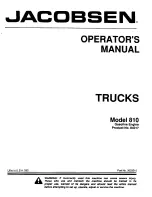
JCB 714 Super-Boss Conversion
SB002
Operator’s Manual
Issue 1, R2
Last Updated 5 April 2017
Page 39 of 43
Emergency Recovery Off Tracking
Emergency off tracking may be necessary during the working lifespan of the machine. It must be stressed
that this is an EMERGENCY PROCEDURE ONLY and should not be used in the normal cause of events. If
you are asked to off track using this method, at an unprepared location, without suitable justification you
should report to your on-call manager and ask their advice before attempting this manoeuvre.
If there is real cause to use this method certain procedures must be followed:
•
The off tracking area must be inspected for its suitability as normal.
•
An area where there are no obstructions should be selected. For example, there should be no
conductor rail present, no high ballast shoulders and no obvious hazards.
•
Emergency off tracking must not be carried out on cants.
In the event of a real emergency the procedure for off tracking is as follows:
•
Approach the off tracking at a safe speed.
•
Sound the horn to alert personnel at the off tracking area as you approach.
•
Raise all of the rail wheels.
•
Drive the machine clear of the running rail.
When carrying out this operation always follow any hand signals and carry out all movements smoothly at a
safe speed.
Emergency Recovery
If your machine breaks down in such a position that it is likely to obstruct an adjacent line or cause an
accident or damage to the railway infrastructure or any other vehicle, it is important that the machine is
placed in a safe position as soon as possible. For this reason the JCB 714 has been fitted with a manual
recovery pump and tow bar by which another machine can tow it to safety.
Instructions on how the recovery pump works are described below, you must make a point of reading and
understanding the procedures so that in the event of a machine failure you are able to put the machine in a
safe position.
The main points are:
•
Connect your machine and recovery vehicle together with the approved tow bar.
•
Select the required rail gear with the tap on the hand pump, making sure that the screw tap on the
side of the pump is screwed in. Doing this raise the rail gear so there is approximately 10mm
between the road wheel and the drive trumpet.
•
When using the hand pump the rail gear will move very slowly.
•
Only release raise the rail gear of the failed machine once the tow bar has been connected to the
recovery vehicle otherwise the machine might run away.
•
Ensure that towing is carried out at a slow speed approximately 2 mph as the recovery vehicle has
to brake for both vehicles, at a higher speed braking distance would be greatly increased.
Recovery Pump
WARNING - the machine should be coupled to the towing vehicle before this procedure is followed. The
machine’s brakes are disabled when it is in free-wheel mode. Failure to couple the machine initially may
result in it rolling away.
There is a tap on the recovery pump to direct the flow to the rail gear or to the module attached. Once the
axles have been selected use the hand pump to lift the rail gear. Make sure screw tap is tightened. The lever
and electronics in the cab do not need to be operated to raise the axles.




























